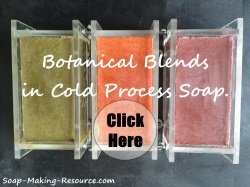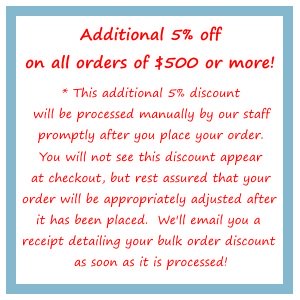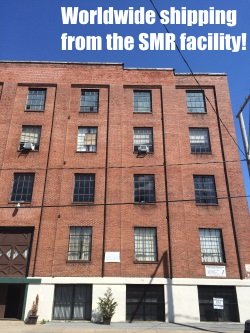Honey Oatmeal Soap Recipe
The following is a wonderful honey oatmeal soap recipe that I think you will absolutely love. In this full soap recipe tutorial, we will explore exactly how to use honey in soap. Furthermore, I will demonstrate a wonderful natural essential oil blend using therapeutic grade clove bud and sweet orange essential oils. You won't want to miss out on that. It's a perfect scent for any honey oatmeal soap!
My honey soap recipe will also incorporate fresh homemade almond milk that I will show you how to make and incorporate into your batch. We will be using ground up oatmeal in this recipe as well.
For a final touch, we will give each of our finished bars a honey comb design using a simple soap decoration technique that you will love so much that you'll probably use it again and again for all your honey soap bars!
This recipe will make 5 pounds of soap and will work perfectly with our 5 pound acrylic slab soap mold.
Don't worry! All will be explained below in great detail and helpful pictures will be included for each step. Enjoy!
Take a look at a picture of the final soap that we will be creating below. If you think this soap looks nice, you should try smelling the thing!
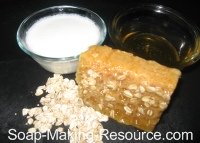
Get the Kit! (Out of Stock)
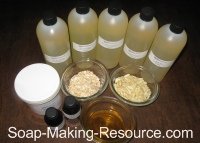
The honey oatmeal soap recipe is now available as a soap making kit right here at soap-making-resource.com. The kit will include 32 ounces olive oil, 16 ounces sweet almond oil, 16 ounces of avocado oil, 16 ounces castor oil, 13.5 ounces coconut oil, 2.5 ounces of honey, 2 ounces of natural whole oats, 1/3 cup almonds to make your own almond milk, 2 ounces sweet orange essential oil, 2 ounces clove bud essential oil and bubble wrap to give your bars a honeycomb design.
In this kit you will have more than enough ingredients to make the 5lb batch of honey oatmeal soap as described below! You may want to pick up separately our 5lb acrylic slab soap mold that will work perfectly with this honey oatmeal soap recipe. Full written instructions for completing this recipe will also be provided with your kit!
Honey Oatmeal Soap Recipe Kit: $54.45 Out of Stock
* The honey oatmeal soap recipe kit will not include sodium hydroxide (due to shipping regulations) or distilled water. I will include contact information for my personal source of lye with your kit! Many hardware stores also carry pure sodium hydroxide, so you may be able to pick some up locally. You can pick up distilled water at your local grocery store!
Although Soap Making Resource offers soap making kits for your convenience, all ingredients are also available to purchase in bulk quantities right here at soap-making-resource.com
Here is the honey oatmeal soap recipe that I will be using:
- Olive Oil = 26.5 Ounces (50% of total oils)
- Coconut Oil (76 Degree) = 10.6 Ounces (20% of total oils)
- Sweet Almond Oil = 6.4 Ounces (12% of total oils)
- Avocado Oil = 5.3 Ounces (10% of total oils)
- Castor Oil = 4.3 ounces (8% of total oils)
- Honey = 2.5 ounces
- Almond Milk = 6 ounces
- Whole Oats = 2 ounces
- Orange, sweet essential oil = 45 grams
- Clove Bud essential oil = 30 grams
- Distilled Water = 12 ounces
- lye = 7.281 ounces (206 grams)
*This recipe has a 5% super-fat.
*All measurements are weight measurements, not liquid measurements.
Finally, let's take a look at the step by step process for creating this batch:
Step 1) for our first step, we are going to create the lye solution. Carefully measure out 206 grams of dry lye in a chemical safe container. I like to use a simple HDPE plastic bucket to measure out my lye.
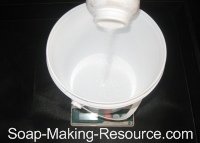
Next, measure out your 12 ounces of distilled water. It is important here that you use distilled water. Faucet and even filtered water can have minerals and additives in it that will have an adverse affect in your soap during the saponification reaction.
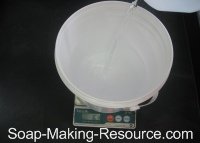
As mentioned previously, for a 5 pound recipe like this one, we would typically use 20 ounces of water instead of 12 ounces. The remaining liquid needed for this batch, however, will be made up of the almond milk and honey additives that we will be incorporating later on in this honey oatmeal soap recipe.
Finally, now that your dry lye and distilled water is measured out, pour the sodium hydroxide (lye) into the water.
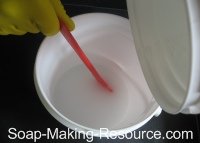
When the lye and water combine, you will notice that the solution will instantly heat up and a strong fume will be present. Be sure to create this solution in a well ventilated area so that you can avoid inhaling these fumes! After just a brief period of time, the fumes will no longer linger.
Now place a thermometer into your lye solution and place it safely off to the side where it won't accidentally be knocked over. We are going to let the lye solution cool while we complete the other steps in our honey oatmeal soap recipe.
For this batch, we want the lye solution to cool down almost to room temperature. More will be explained further down this page as to why we need the lye to be cooler than normal for this recipe.
Step 2) now that our lye solution is created and set aside to cool, we are going to measure out our soap making oils according to the honey oatmeal soap recipe above. Do this in your stainless steel soap pot.
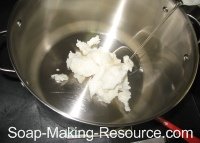
Once all your oils are accurately measured, you can begin to melt the oils down using a low heat on your cooktop.
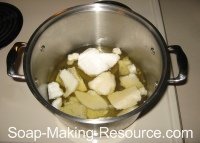
Step 3) while the oils melt and the lye solution continues to cool, we are going to prepare our additives needed for this honey oatmeal soap recipe.
First, let's prepare our honey. We will be incorporating honey into this soap recipe at the rate of 1/2 ounce per pound of soap. So, for a 5 pound batch, we will need to weigh out 2.5 ounces of honey. Be sure to use 100% pure honey without any additives!
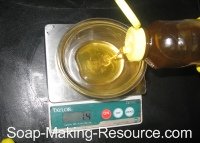
We do not want to add the honey to the soap in its original viscous form. If we add the honey without thinning it out, it will be difficult to thoroughly mix it evenly into the batch and consequently your soap could have sporadic dark honey patches in it.
To dilute and thin out your honey, mix the 2.5 ounces into 3 ounces of warm distilled water. Stir until all the honey is completely dissolved.
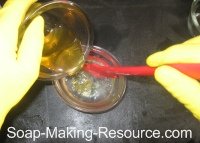
Now set this warm honey-water off to the side for future use.
Next, we are going to prepare our almond milk. Making almond milk is very easy! Simply mix 1 part almonds to 3 parts distilled water in a blender and then strain out the pulp! You will be left with 100% pure unadulterated and very creamy almond milk.
Our honey oatmeal soap recipe calls for 6 ounces of almond milk. I usually make a bit more than what is needed as it is difficult to make exactly 6 ounces of the milk as the weight changes once the pulp is removed.
So, to make sure that I have enough milk for my batch, I am going to measure out 1 cup of water and add 1/3 cup of almonds to my blender and begin to blend. This will make a tiny bit more almond milk than what we need.
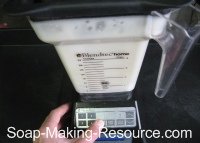
Once the almonds and distilled water are thoroughly blended, strain out the pulp from the almond milk using a fine strainer. I personally like to use a paint strainer bag for this step. They work perfectly for straining nut milks! You can pick one up at almost any hardware store.
Now measure out the needed 6 ounces of almond milk.
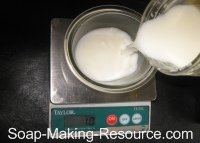
Place the almond milk off to the side for future use.
The next additive that we will be preparing is our colloidal oatmeal. Colloidal oatmeal is simply finely ground whole oats. To create this additive, grind up the needed amount of old fashioned whole oats in a coffee grinder.
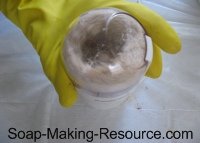
That's all you need to do! Just make sure that you are using old fashioned 100% all natural whole oats and not quick oats. Quick oats will form a goop in your soap!
Now measure out 2 ounces of this oatmeal powder that you just created into a bowl and set aside for future use.
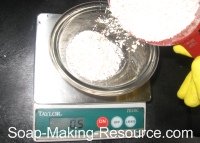
Finally, we need to prepare our essential oil blend. In total, we will be adding 75 grams of essential oils (approximately 2.65 ounces) to this five pound batch of soap.
|
Sign Up Today!
*Your information is SAFE with us! |
For this honey oatmeal soap recipe we will be creating a blend of 45 grams sweet orange essential oil and 30 grams clove bud essential oil. This aroma is truly intoxicating and a perfect match for any honey soap recipe.
I always recommend that you measure out each essential oil separately, so that if you over measure; you can always remove some of the essential oil. Obviously, this wouldn't be possible if you are measuring out the essential oils into the same dish.
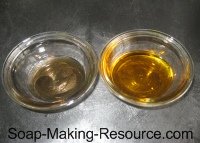
Once the sweet orange essential oil and clove bud essential oil are accurately weighed, combine the two essential oils into the same dish and set it off to the side for future use.
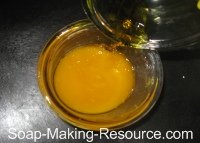
Step 4) while you were preparing all your additives so that they are completely ready to add to your batch when the time in the soap making process is right, your oils should have melted down fully.
Next we need to cool our oil mixture. Remove your stainless steel soap pot from the burner and place it in a sink filled with ice water. This will help our oils cool down to less than 90 degrees very quickly. You can also cool your lye solution using this same method.
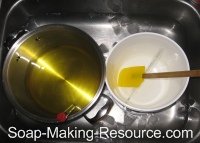
It is extremely important when making honey soap that you "soap cool". This means that both the oil mixture and lye solution should be close to room temperature before you start combining the ingredients to make soap.
The natural sugars in honey will cause your batch to heat up excessively during saponification. To offset this occurrence, and keep the soap from overheating, you need to combine your oils and lye mixture at a much cooler temperature than normal. If the soap gets too hot, it can result in unsightly cosmetic flaws.
Because we made the lye solution in the very beginning of this tutorial it should be substantially cooled down by now. If it is still too warm though, you can use the same "ice bath method" as explained above to cool the lye.
Step 5) we are getting really close now to finally making soap. We just need to complete one last important step before we can combine all the ingredients. You need to prepare your mold!
Because this is a honey oatmeal soap recipe, I really want my bars to have a honeycomb appearance to them. I think that this unique styling will add a really cool creative aspect to my finished product.
To create this honeycomb soap bar style, simply take a piece of bubble wrap, cut it to size, and lay it on the bottom of your tray soap mold. Be sure that the bubbles are facing upwards so that when you pour your soap, the soap solidifies around the bubbles.
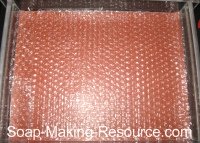
As you will see at the very end of this tutorial, we will be placing another piece of bubble wrap onto the top of the soap to create an identical effect on both sides of each bar. Be sure to cut an extra piece of bubble wrap to the size of your mold so that you can accomplish this last step!
For this tutorial, I am using the Soap Making Resource 5 pound acrylic slab soap mold. This slab mold design makes it very easy to complete the honeycomb styling technique as shown above. It is a bit harder to do with a log soap mold.
Step 6) At this point, your lye solution and oils mixture should be at right around room temperature, your additives should be ready for pouring and your soap mold should be completely prepared with bubble wrap lining the bottom. We are finally ready to make soap!
Slowly pour the lye solution into your oils mixture and stir manually with a silicone or stainless steel mixing utensil. Don't get out the stick blender just yet!
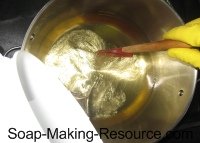
Keep stirring manually for just a few minutes until your soap is an even color and texture. Now, while your soap is still very thin, pour in your almond milk.
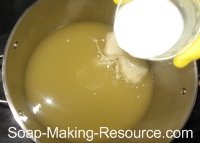
Immediately after pouring the almond milk into your soap, dump in your honey/water mixture.
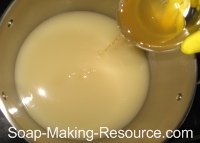
It is somewhat important that you pour the almond milk and honey/water mixture into your batch before the soap gets too thick. These two liquid additives are making up for our lack of water in the lye solution and consequently should be added very soon after you pour the lye solution into the oils. Also, the honey can speed up trace significantly, so if you wait too long, your soap can seize up on you and solidify in the pot once you add the honey.
Some soap makers will add the milk and honey to the lye solution itself and then pour the entire mixture into the soap making oils. I, however, do not like that method.
Unfortunately, if you add the honey directly to the lye solution, the sugars in the honey can cause the solution to "volcano" and overflow. This usually only happens when the lye solution is still warm, but why take the risk?
Keep mixing your soap batch with the newly added almond milk and honey manually until you once again have an even color and texture.
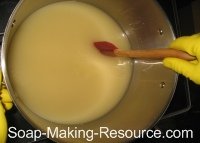
We are not using our stick blender just yet because honey soaps tend to trace very quickly. Mixing your batch with a stick blender will only speed this up. We still have a few more additives to add, so we don't want the soap prematurely hardening up on us!
Next, add your pre-measured colloidal oatmeal and continue to stir manually.
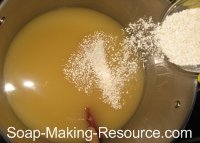
Finally, add your sweet orange and clove bud essential oil blend.
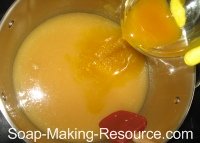
At this point, if your soap is still thin, you can feel free to start mixing with your stick blender to speed up the trace.
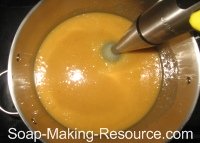
Once your soap starts to thicken up, test it for trace. You can test for trace by dribbling a small amount of soap onto the surface of your batch. If the soap sets on top of the rest of your batch for a brief moment before sinking back into the mixture, then you know you have reached trace. Your soap will probably be about the consistency of mayonnaise.
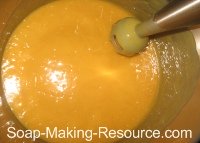
Step 7) once you have successfully reached trace, pour the batch into your bubble wrap lined mold.
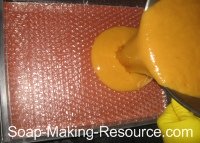
Step 8) once all the soap is poured into the mold, it is time to do a little more styling. Place your second piece of bubble wrap, if desired, onto the top of the soap to give both sides a honeycomb appearance.
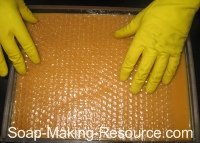
If you own and are using a Soap Making Resource acrylic slab mold, as seen in the picture above, be sure to leave the bar dividers out of the mold until the very end so that the bubble wrap will be able to penetrate the top of the soap.
I actually like to carefully remove this top layer of bubble wrap after a few hours so that I can add some extra oatmeal and honey to the top of my soap while the soap is still wet. I just love the look that this gives!
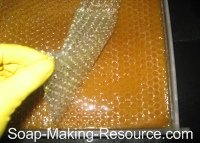
What I do is lightly sprinkle whole oats onto the top of my soap like so:
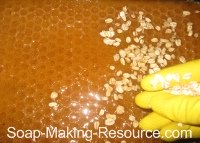
Then I gently drizzle the honey in a diagonal pattern across all the bars.
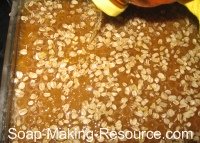
You don't need to smother the soap with extra oatmeal and honey. The purpose is simply to give your bar even more of a decorative flair. A little goes a long way so be sure to use your artistic eye!
Step 9) Finally, if you are using the Soap Making Resource acrylic slab soap mold, insert the bar dividers and place your completed soap in a safe area to cure.
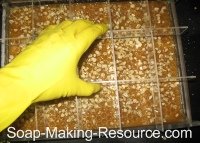
Because of the honey in this recipe, the soap still has a tendency to overheat even though we kept all our soap making ingredients cool. To keep the heat from building, don't put the lid on your mold and do not insulate with towels or blankets. Additionally, you can place the entire batch into your freezer to keep the temperature down! We want to do everything we can to keep the heat from building up too much.
Step 10) after 24 hours, or once the soap is satisfactorily solidified, you can remove it from the mold. If you are using the Soap Making Resource acrylic slab soap mold, this will be easy as each bar is preformed via the dividers. All you have to do is simply pop out each perfect little bar from the mold.
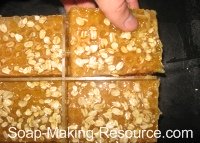
If you are using a Soap Making Resource log soap mold, you can always use our guided soap cutter to evenly slice your bars.
Take each bar and set on a rack to cure. Every week or two, flip the bars so that all sides are exposed to the air at one point or another.
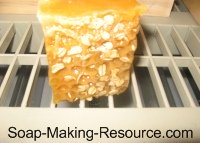
After just a few short weeks, your bars will be extremely hard and ready to give away, sell or, of course, hoard for yourself!
I hope you enjoyed this honey oatmeal soap recipe tutorial! I know that I loved making it! Don't forget to pick up the kit if you want to try this recipe or, of course, you can purchase the ingredients right here individually at soap-making-resource.com.
Return from honey oatmeal soap recipe to the soap recipes hub page.

